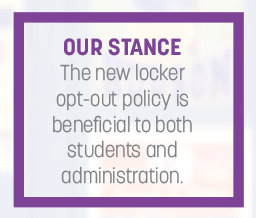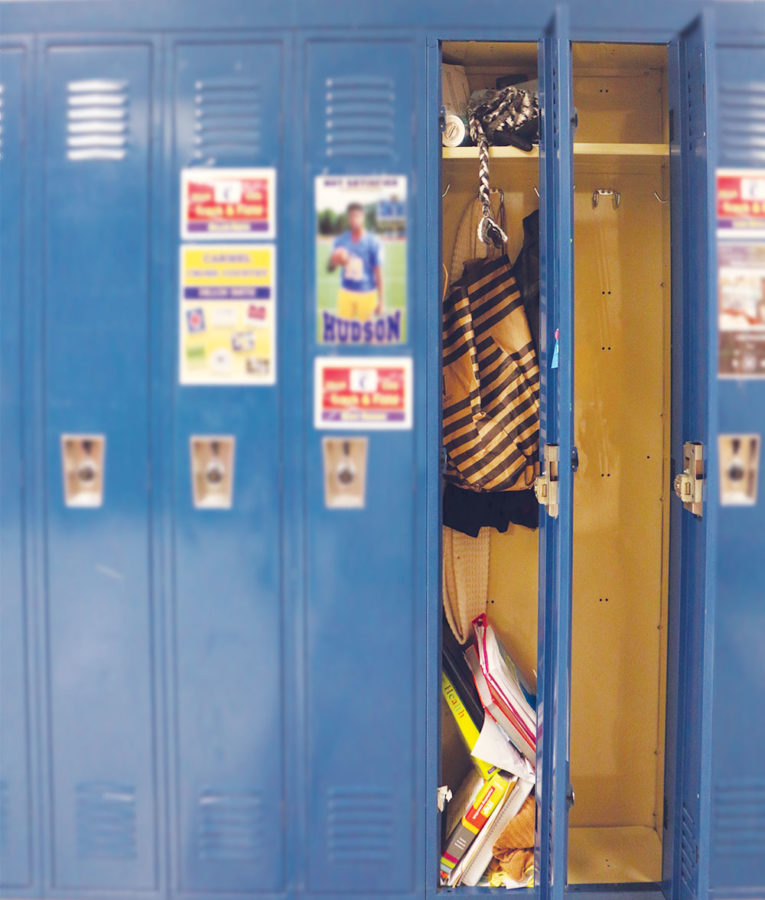To meet the demands of the rising CHS student population, administration is introducing a locker opt-out policy for the 2019-20 school year. This policy is directed at students who do not use their locker due to inconvenience or schedule demands.
To opt out of a locker, students must submit their name, student ID number and grade through a Google form, which can be found on Canvas in the CHS Inform
ation course. Students who change their mind can visit secretary Elizabeth Hayes in the activities office. This policy offers benefits for both students and administration alike. Students who do not use their locker (and successfully organize without it) are freed from an extra responsibility. The nuisance of locker shelves and combinations would cease, eliminating one source of stress during the first and last weeks of the school year.
Ultimately, the school stands to benefit the most. If students opt-out in high numbers, hundreds of lockers would open up throughout the school. As the population of CHS continues to increase, this lessens the need to construct more lockers, allowing CHS to save space. During the short-term (the next three to five years), counselors can give better locker locations to the students who rely on them.
This is the root of the issue. Students who receive more optimal locations could then be more likely to use their lockers at regular intervals throughout the year. Administration has several options to address this fact.
If administration seeks to immediately reduce the amount of vacant lockers, administration should encourage students to request locker locations. Students submit class requests months in advance, and generally know where their classes will be located. Students can easily request preferred locker spots alongside their course requests, and counselors would then work to honor this request.

If administration wants to preserve space, on the other hand, it would benefit them to vacate as many lockers as possible. The opt-out policy is the first step to achieving this goal.
In the end, students benefit from both scenarios. In the first scenario, those who use lockers or plan to use lockers will be given better spots, and there would be less wasted space. In the second scenario, the school can accommodate future students easier as the population keeps growing. The opt-out policy keeps both options open and signifies a proactive move by administration to address both short-term and long-term concerns.

































![AI in films like "The Brutalist" is convenient, but shouldn’t take priority [opinion]](https://hilite.org/wp-content/uploads/2025/02/catherine-cover-1200x471.jpg)










































![Review: “The Immortal Soul Salvage Yard:” A criminally underrated poetry collection [MUSE]](https://hilite.org/wp-content/uploads/2025/03/71cju6TvqmL._AC_UF10001000_QL80_.jpg)
![Review: "Dog Man" is Unapologetically Chaotic [MUSE]](https://hilite.org/wp-content/uploads/2025/03/dogman-1200x700.jpg)
![Review: "Ne Zha 2": The WeChat family reunion I didn’t know I needed [MUSE]](https://hilite.org/wp-content/uploads/2025/03/unnamed-4.png)
![Review in Print: Maripaz Villar brings a delightfully unique style to the world of WEBTOON [MUSE]](https://hilite.org/wp-content/uploads/2023/12/maripazcover-1200x960.jpg)
![Review: “The Sword of Kaigen” is a masterpiece [MUSE]](https://hilite.org/wp-content/uploads/2023/11/Screenshot-2023-11-26-201051.png)
![Review: Gateron Oil Kings, great linear switches, okay price [MUSE]](https://hilite.org/wp-content/uploads/2023/11/Screenshot-2023-11-26-200553.png)
![Review: “A Haunting in Venice” is a significant improvement from other Agatha Christie adaptations [MUSE]](https://hilite.org/wp-content/uploads/2023/11/e7ee2938a6d422669771bce6d8088521.jpg)
![Review: A Thanksgiving story from elementary school, still just as interesting [MUSE]](https://hilite.org/wp-content/uploads/2023/11/Screenshot-2023-11-26-195514-987x1200.png)
![Review: "When I Fly Towards You", cute, uplifting youth drama [MUSE]](https://hilite.org/wp-content/uploads/2023/09/When-I-Fly-Towards-You-Chinese-drama.png)
![Postcards from Muse: Hawaii Travel Diary [MUSE]](https://hilite.org/wp-content/uploads/2023/09/My-project-1-1200x1200.jpg)
![Review: "Ladybug & Cat Noir: The Movie," departure from original show [MUSE]](https://hilite.org/wp-content/uploads/2023/09/Ladybug__Cat_Noir_-_The_Movie_poster.jpg)
![Review in Print: "Hidden Love" is the cute, uplifting drama everyone needs [MUSE]](https://hilite.org/wp-content/uploads/2023/09/hiddenlovecover-e1693597208225-1030x1200.png)
![Review in Print: "Heartstopper" is the heartwarming queer romance we all need [MUSE]](https://hilite.org/wp-content/uploads/2023/08/museheartstoppercover-1200x654.png)




